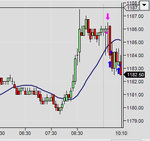DionysusToast
Legendary member
- Messages
- 5,965
- Likes
- 1,501
That would be the Time and Sales, although the originating trader could have split it up (you can't see the T+S in that video)
On any CME based exchange, the trades have been split up anyway now. 🙁
Let's say you have bids of 100,200,4,5,24 on the inside to make a total of 333 contracts there & someone puts in a market order to sell for 333 contracts. What you would have seen previously would be a single print of 333 contracts. After the CME made changes (almost a year ago?), you know see 5 prints 100, 200, 4,5,24.
So - small prints don't mean small market orders. They could be a large market order being filled against small limit orders.
Nowadays, a large print at the bid signifies a large limit order on the bid side as well as a potentially larger market order.
I was working on a new Time & Sales which effectively reconstructed these split up market orders but I heard the CME were considering backing out the recent changes after complaints from various traders who rather liked to see the larger prints coming through and what it implied about intent of the bigger traders.


